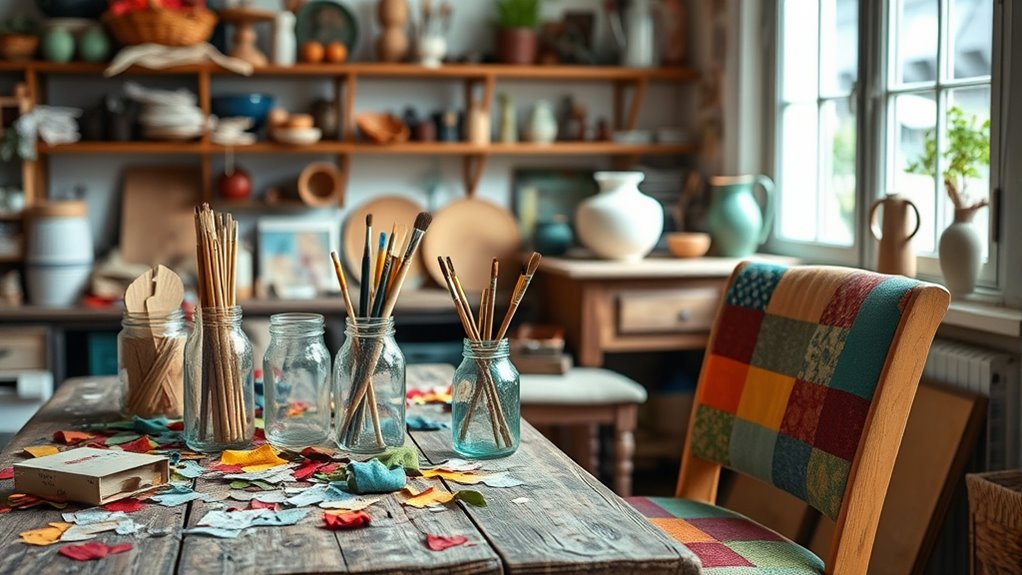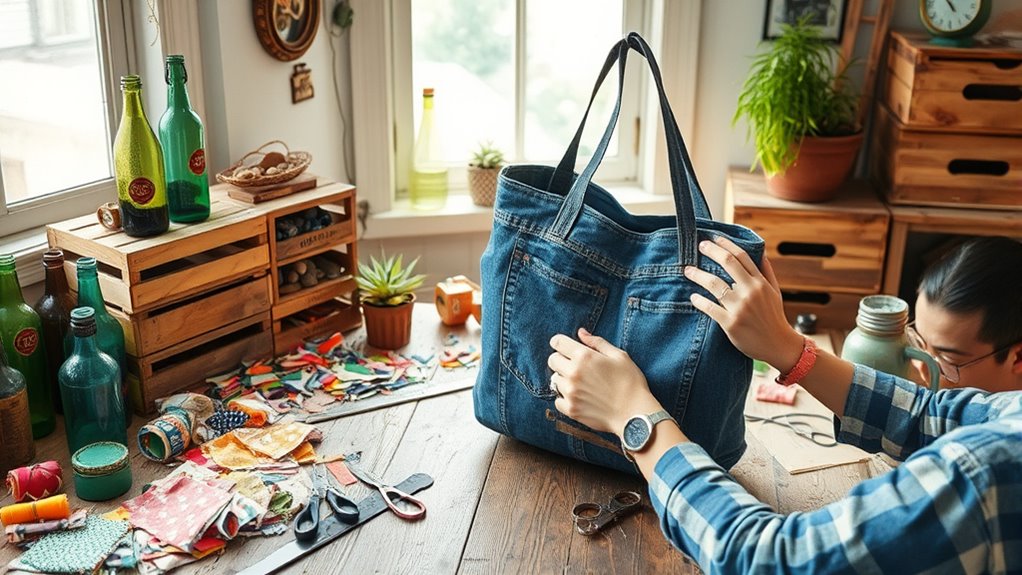Upcycling is a creative way to give old or discarded items a fresh purpose while helping the environment. You can transform furniture, pallets, or everyday objects into unique, valuable pieces with simple tools and eco-friendly materials like recycled paints or fabrics. Focus on sanding, cleaning, and customizing to match your style, and incorporate reclaimed elements for added charm. Keep exploring how this sustainable practice can elevate your home decor and reduce waste—there’s much more to discover.
Key Takeaways
- Upcycling transforms old or unused items into new, valuable products, reducing waste and environmental impact.
- Use simple tools and eco-friendly materials like sustainable paints and recycled fabrics for safe, effective projects.
- Techniques such as decoupage, distressing, and incorporating reclaimed hardware add uniqueness and character.
- Focus on patience, proper preparation, and allowing adequate drying time to ensure a professional-looking finish.
- Upcycling promotes sustainability, saves money, and offers a rewarding way to personalize home decor.

Upcycling is a creative and eco-friendly way to transform old or unused items into something new and valuable. Instead of tossing out worn-out furniture or discarded objects, you can breathe new life into them by repurposing and redesigning. This approach not only reduces waste but also allows you to customize pieces to match your style and needs. When you plunge into upcycling, you’ll find that creating DIY furniture is a popular avenue. You don’t need to be a professional carpenter—simple tools and a bit of imagination are enough to turn an outdated table or chair into a statement piece. The key is to work with eco friendly materials whenever possible, which means selecting sustainable paints, stains, and finishes that minimize environmental impact. Using eco friendly materials helps keep your project safe for your home and the planet, making your upcycled item even more meaningful.
Getting started with upcycling involves evaluating what you already have. Look around your home for furniture or objects that could benefit from a fresh look. A worn-out dresser, an old wooden ladder, or even pallets can become the foundation for a stylish piece. Before you begin, do some research on the best eco friendly materials to use—these may include natural oils, non-toxic paints, or recycled fabrics. When working on your DIY furniture project, prepare your workspace with all the necessary tools and safety gear. Sanding, cleaning, and priming surfaces are essential steps to guarantee your upcycled piece looks professional and lasts longer. Remember, patience is key; multiple coats of paint or sealant might be needed for a smooth finish. Incorporating recycled materials into your projects can further enhance their sustainability and uniqueness.
As you work with eco friendly materials, don’t shy away from experimenting with different techniques such as decoupage, stenciling, or distressing to add character. Recycling old hardware or incorporating reclaimed elements can elevate your project and make it uniquely yours. Upcycling isn’t just about saving money—it’s about making sustainable choices and expressing your creativity. When you finish your DIY furniture, you’ll enjoy the satisfaction of having transformed something old into a functional and attractive piece that highlights your commitment to sustainability. Plus, every upcycled item helps reduce demand for new resources and cuts down on waste. So, take your time, choose eco friendly materials, and enjoy the process of giving products a second life while making your home more stylish and environmentally conscious.
Frequently Asked Questions
What Safety Precautions Should I Take When Upcycling?
When upcycling, you should always prioritize safety. Wear appropriate safety gear like gloves, goggles, and a mask to protect against dust, chemicals, or sharp objects. guarantee good ventilation precautions by working in a well-ventilated area to avoid inhaling fumes or dust. Keep a first aid kit nearby, handle tools carefully, and follow manufacturer instructions. Taking these steps helps you stay safe while transforming old items into new treasures.
How Do I Choose the Right Materials for Upcycling?
Choosing the right materials for upcycling is like selecting the best ingredients for a recipe; you want quality and purpose. Look for items with clear recycling symbols to understand their origin. Consider material durability—opt for sturdy, long-lasting pieces to guarantee your project stands the test of time. Avoid fragile or overly processed materials that might not hold up. Your goal is to create something beautiful and functional that breathes new life into old items.
Can Upcycling Be Profitable as a Business?
You can definitely turn upcycling into a profitable business by analyzing market demand and tailoring your products accordingly. Focus on unique, eco-friendly items that appeal to conscious consumers. Use strong branding strategies to highlight your sustainability efforts and craftsmanship. By understanding your target audience and emphasizing quality and originality, you can stand out in the market and generate sustainable profits through upcycling.
What Tools Are Essential for Beginner Upcyclers?
When starting out with upcycling, you need essential tools that support sustainable practices and effective upcycling techniques. A good pair of scissors, a hot glue gun, sandpaper, and paintbrushes are key for refurbishing and customizing items. You’ll also want safety gear like gloves. These tools help you transform old products into new, eco-friendly creations while minimizing waste, making your upcycling projects both fun and sustainable.
How Do I Find Inspiration for Upcycling Projects?
To find inspiration for upcycling projects, start exploring recycling communities where people share creative ideas. Join local groups or online forums to see what others are making. Additionally, browse social media platforms like Pinterest and Instagram, searching for upcycling hashtags. These sources provide endless visual inspiration and practical tips, helping you discover new techniques and ideas to transform everyday items into something unique and eco-friendly.
Conclusion
By embracing upcycling, you turn waste into wonder and give products a fresh purpose. Remember, “One man’s trash is another man’s treasure,” so don’t hesitate to get creative and breathe new life into old items. Every small effort adds up, helping the planet and your home. So, start small, stay inspired, and watch your projects transform, proving that with a little imagination, you can make a big difference.









